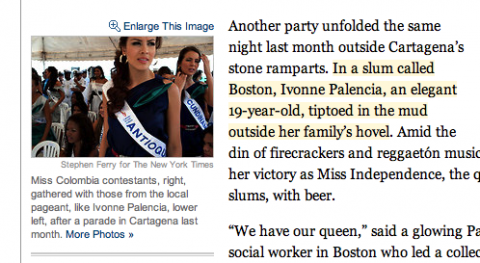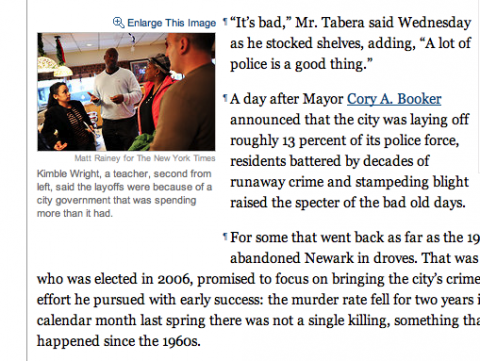The NYTimes recently introduced a new feature that allows users to link to and highlight individual sentences and paragraphs in its web stories. I am impressed!
I agree with Courtney Boyd Myers: While it could be a tad complicated for an average reader, it’s a great tool for writers and bloggers who frequently link to NYTimes stories.
Here’s how it works. Take the base URL: http://www.nytimes.com/2010/12/01/world/americas/01colombia.html
To link to a specific paragraph, simply add a “#” and the number of the paragraph, e.g.: http://www.nytimes.com/2010/12/01/world/americas/01colombia.html#p2
To go a step deeper and skip to a particular sentence, try e.g.: http://www.nytimes.com/2010/12/01/world/americas/01colombia.html#p2s2
And where it gets really gets cool: To highlight that section, simply switch the p to an h. e.g.: http://www.nytimes.com/2010/12/01/world/americas/01colombia.html#h2s2

To simplify things, if you hit your shift key twice on a Times story, small icons appear next to every paragraph. Click on one of them and it’ll place the paragraph linked URL up in the address bar of your browser.

Read the full article over on TheNextWeb: The New York Times Introduces The Evolution of the Hyperlink, by Courtney Boyd Myers.
Hopefully more sites will adopt this feature. Hat tip, NYTimes!
(via @davidbauer)
Wow! I’m impressed!
-J
Dec 2nd, 2010 / 10:00 am
and for the rest of the internet: http://www.awesomehighlighter.com/
Dec 2nd, 2010 / 10:18 am
Another cool thing the NY Times does is having an instant dictionary available. Double click on any word in an article, and a little question mark icon will pop up. Click that, and you can see the definition of the word. Pretty neat.
Dec 2nd, 2010 / 10:31 am
The paragraph shuff if rather lame – sentance highlighting is so and so.
I’d be impressed if they had allowed readers to contribute links to storys. That’s something I’d really like to do all the time while reading articles in online newspapers.
Dec 2nd, 2010 / 11:16 am
It takes a moment for the highlighting to load after the page loads, I wonder why?
Dec 2nd, 2010 / 8:32 pm
Check it out – this is doable with jQuery. http://bit.ly/ezcMk3
Dec 3rd, 2010 / 10:17 am
I wouldn’t say it’s evolutionary, rather it is a rudimentary use of javascript that finds text and punctuation marks nested between open & close p tags.
With the following link you would expect it to link to and highlight the second sentence of the second paragraph. http://www.nytimes.com/2010/12/03/world/europe/03assange.html?pagewanted=2&hpw#h2s2
Since the script is skipping to the second instance of the open & close p tag, what you actually get is the first sentence of the first paragraph highlighted with the subject’s title omitted. The text “(Page 2 of 2)” counts as the first paragraph and “Mr.” is recognized as the first sentence.
It would be less confusing had they coding with simple html anchors instead.
Dec 3rd, 2010 / 12:37 pm
And I’ld look less idiotic had I written coded instead of coding. Damn.
Dec 3rd, 2010 / 12:42 pm
This reminds me of how one might cite a biblical text!
Jan 19th, 2011 / 3:10 am
How one cites a religious text and how one links to a certain paragraph of a hyperlink is very similar.
Jan 19th, 2011 / 3:10 am
This immediately made me think of religious texts and how they are formatted so that they may easily be cited. When one cites a passage from a religious text or bible, they use an advanced form of verbal hyperlink. Now hyperlinks have evolved into advanced texts, just like humans had in early history.
Jan 19th, 2011 / 3:13 am